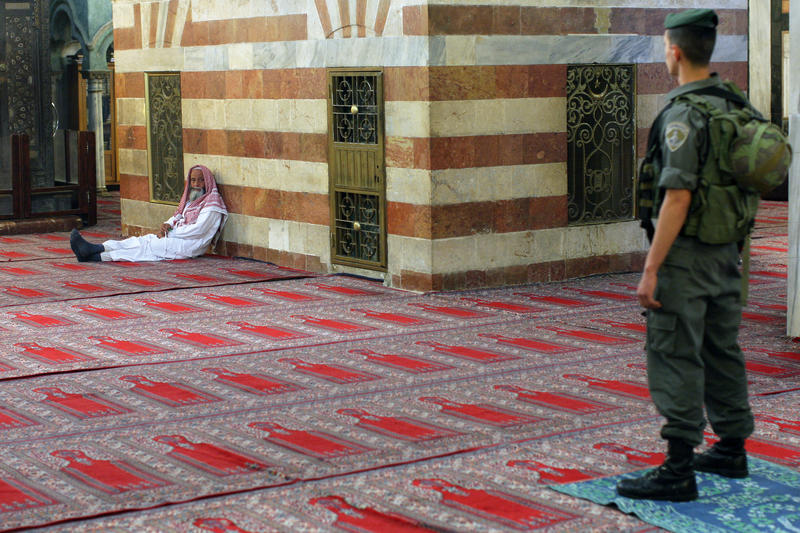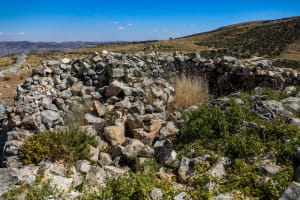Abraham, Isaac and Jacob’s ancient tomb in Hebron, Israel: The Cave of Machpelah

The Cave of Machpelah in Hebron – Me’arat HaMakhpéla in Hebrew – is the burial place of the biblical patriarchs and matriarchs: Abraham and Sarah, Isaac and Rebekah, Jacob and Leah are all buried there. Only Rachel, Jacob’s beloved wife, is not buried in this place; her tomb is in Bethlehem, at Rachel’s Tomb.
Because of its significance, the Cave of Machpelah is considered the second-holiest site in Judaism after the Temple Mount in Jerusalem. It was already a pilgrimage site in ancient Israel, and for the past 2,000 years, Jews, Christians and Muslims alike have regarded it with deep reverence.
The monumental, rectangular stone structure that stands above the cave today was built by Herod the Great around 2,000 years ago – the same king who expanded and strengthened the Second Temple in Jerusalem. The Herodian structure above Machpelah is unique: it is the only fully intact Herodian-era building that still stands in Israel. Its massive, precisely cut stone blocks, symmetrical joints, and colonnaded courtyard make it one of the finest and best-preserved examples of early Roman architecture.
The cave itself is a natural, multi-level karstic cave system that was used for burial in ancient times. Although access to the inner chambers has been restricted for centuries by the Muslim religious authorities, archaeological research, ground-penetrating radar surveys, and historical sources all confirm the site’s antiquity and its continuous use as a burial place.
Abraham's right to the Land
Hebron lies in the southern highlands, in the Judean Mountains, within a territory whose political status is disputed by the international community. The Bible clearly associates the city with the land of Judah: “And they gave them Kirjath Arba (Arba was the father of Anak), which is Hebron, in the mountains of Judah.” (Joshua 21:11). Throughout history, Hebron was always one of the central cities of the Judean region, and in the early years of King David’s reign it served as the capital of Judah: “And the time that David was king in Hebron over the house of Judah was seven years and six months” (2 Samuel 2:11). Although the international community does not recognize it today as part of the State of Israel, historically and symbolically it has always been regarded as the heart of Judea.
The Jewish right to the land, however, reaches even further back – long before Joshua’s conquest – returning to Abraham himself. According to the Bible, Abraham first settled in this area after obeying the divine command and arriving in the land of Canaan. He possessed the Cave of Machpelah and the field surrounding it not only by divine promise, but also through a public legal transaction witnessed by the community – he purchased it from Ephron the Hittite.
Genesis 23 gives a detailed account of how Abraham bought the cave for 400 shekels of silver, with full legal validity, at the city gate and in the presence of the people. The Jewish claim to the land thus rests not only on divine promise, but also on the oldest documented legal acquisition recorded in Scripture.
There is also an interesting historical parallel: before the establishment of the modern State of Israel, Jewish individuals and organizations likewise purchased land from local inhabitants. These land acquisitions – which comprised about 30% of the territory allotted to Israel in the 1947 UN Partition Plan – laid the groundwork for the process that eventually led to the founding of the state in 1948.

Where God’s promise, faith and history meet
The Cave of Machpelah is a unique place, at once an ancient family tomb, a historical monument, and a pilgrimage site where the Bible, archaeology, and collective memory converge. Here, the promise and its fulfillment, human history and divine guidance, are interwoven.
Together with the countless archaeological discoveries found throughout Israel, the ancient monument built above Hebron’s cave stands as further evidence that the Jewish people’s connection to the land is not a modern political assertion, but is rooted in God’s promise and in historical realities that begin with Abraham and have endured across the generations. Where Abraham purchased his first piece of land, God’s promise became tangible. The Promised Land is not an abstract idea but a real place where God has acted – and continues to act – in history.
Thus, the tomb of the patriarchs does not only point to the past. In the midst of contemporary debates and future hopes, it serves as a compass, reminding us that God always fulfills His promise – in history, in the destiny of nations, and in the life of every individual.

Is All Israel News’ faith-based reporting important to you? Be part of it—help us continue by becoming a $5/month supporting partner.

The All Israel News Staff is a team of journalists in Israel.
You might also like to read this:















